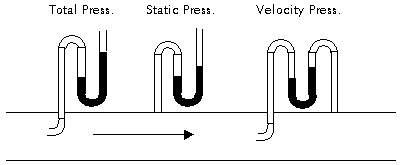| What
to predict the pumping head at the design water flow
rate from measurement made at the test water flow rate
is very important. The below example will show how to
compute the pumping head.
Example 19-1:
Determine the pumping heat for the assumption which
the static lift (D) was 35 feet and vertical distance
(h) of the pressure gauge above the basin curb was 5
feet. At this point, the pressure gauge indicated 25
psig. The 24 inch of pipe was used and the inner diameter
was 22.624 inch. Let's assume that the test water flow
rate was 14,000 GPM.


(Solution)
First, let's determine the equivalent length of piping
and fittings between the point of pressure gauge and
the center of inlet pipe.
- Vertical Leg, Length of
D - h = 35 - 5 = 30.0 ft
- Horizontal Leg from the
center of riser pipe and inlet pipe = 5 ft
- 24", 90o
Welding Elbow (r/d = 1), Equivalent Length = 37.7
ft (from table of friction loss in term of length)
Then, total equivalent length = 30 + 5 + 37.7 = 72.7
ft (based on 24 inch pipe)
Second, determine the friction
loss in piping and fitting between the point of pressure
gauge and center of inlet pipe. The head loss for 24
inch pipe per 100 feet and for 14,000 of test water
flow rate is 1.30 ft from the friction table of steel
pipe. Then, the friction loss in the feet could be obtained
from below;
- Friction Loss = Head Loss
per 100 ft x Equivalent Pipe Length = 1.30 / 100 x
72.7 = 0.95 ft
Third, determine the static
pressure of test water flow at the center of inlet pipe.
- SPt = Test Pressure -
(D - h) - Friction Loss = 25 psig x 2.309 - (35 -
5) - 0.95
(Note: 1 psi = 2.309 feet)
= 26.78 ft
Fourth, determine the velocity
pressure of test water flow at the enter of inlet pipe.
- Water Velocity @ 24 inch
pipe = GPM x 0.1336798 / (0.7854 x (Inner Diameter
/ 12)2) = 14,000 x 0.1336798 / (0.7854
x (22.624 / 12)2 = 670.39 ft/min = 11.17
ft/sec
- Velocity Pressure = Velocity2
/ 2g = 11.172 / (2 x 32.174) (1g = 32.174 ft/sec2)
= 1.94 ft
Fifth, let's compute the
test pumping head
Test Pumping Head = SPt +
Velocity Pressure + Static Lift = 26.78 + 1.94 + 35
= 63.72 ft
Sixth, determine the corrected
total pressure to the design water flow rate.
- Test Pumping Head = Test
Static Pressure + Test Velocity Pressure + Static
Lift
- Test Total Pressure =
Test Static Pressure + Test Velocity Pressure
- Test Pumping Head = Test
Total Pressure + Static Lift
- Test Total Pressure =
Test Pumping Head - Static Lift
- Corrected Total Pressure
= Test Total Pressure x (Design Water Flow Rate /
Test Water Flow Rate)2 = (Test Pumping
Head - Static Lift) x (Design Water Flow Rate / Test
Water Flow Rate)2 = (63.72 - 35) x (12,500
/ 14,000)2 = 22.90 ft
Finally, determine the predicted
pumping head at the design water flow rate.
- Corrected Pumping Head
= Corrected Total Pressure + Static Lift = 22.90 +
35 = 57.90 ft
|